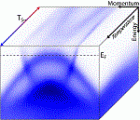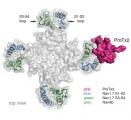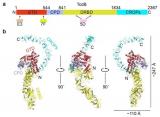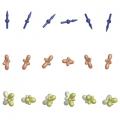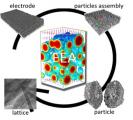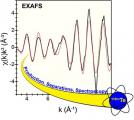Organisms including microbes, plants, and animals can interpret light as a signal for action. While this is a fundamental and important process, the mechanism still holds mystery. How are photons converted into molecular signals? At the most basic step, a light-sensing molecule, a chromophore, undergoes a conformational change, an isomerization, when it encounters a photon. Many details are still unknown, which impacts efforts to engineer artificial light-sensing systems based on natural systems. A team of scientists has illuminated the importance of the immediate electrostatic environment of the chromophore on photoisomerization.
Approximately 1,700 scientists visit SSRL annually to conduct experiments in broad disciplines including life sciences, materials, environmental science, and accelerator physics. Science highlights featured here and in our monthly newsletter, Headlines, increase the visibility of user science as well as the important contribution of SSRL in facilitating basic and applied scientific research. Many of these scientific highlights have been included in reports to funding agencies and have been picked up by other media. Users are strongly encouraged to contact us when exciting results are about to be published. We can work with users and the SLAC Office of Communication to develop the story and to communicate user research findings to a much broader audience. Visit SSRL Publications for a list of the hundreds of SSRL-related scientific papers published annually. Contact us to add your most recent publications to this collection.
In superconducting materials, electron clouds can align into a specific order termed nematicity, a word taken from a root meaning string-like and previously used for alignment of molecules in liquid crystal displays (LCDs). Most iron-based high temperature superconductors (FeSCs) exhibit nematic order and magnetic order in conjunction with superconducting behavior. Iron selenide (FeSe) is a type of FeSC material that obtains nematic but not magnetic alignment prior to reaching the superconducting state. This provides an excellent opportunity to disentangle the contribution of these two orders that usually emerge simultaneously. Studies of FeSe have faced the challenge that FeSe crystals break into orthogonally-oriented domains at the onset of nematic order, a process called twinning. A team of researchers has found a way to detwin FeSe crystals to examine the nematic state to gain a deeper understanding of how it affects superconductivity.
3D printing is revolutionizing the manufacture of products, promising fast and inexpensive ways to make quick prototypes, small batch parts, and unique pieces exactly to specifications. The uses for 3D printed metal range from specialized car parts to custom medical prosthetics. While the potential applications are many, there are limitations due to variable quality and strength of the products. To improve these materials, the science of the manufacturing processes needs to be better understood. Laser powder bed fusion (LPBF) additive manufacturing is a 3D printing process where a three dimensional part is built layer by layer.
Nerve, muscle, and heart cells are activated by the influx of sodium ions into the cells causing an increase in positive charge inside cells. In a carefully regulated system, sodium passes across cell membranes via a variety of sodium ion channels, which open during activation and close when not active. Nav1.7 is a type of sodium channel that has an important role in pain sensation. Dysfunction of Nav1.7 is implicated in diseases that involve the hypersensitivity or hyposensitivity to pain. Due to this role, Nav1.7 is a potential target for therapies that address chronic pain.
Implicated in human cancers including skin, prostate, colon, pancreatic, ovarian, endometrial, and lung, the protein called VISTA (V-domain Ig Suppressor of T-cell Activation) indirectly promotes cancer growth by interfering with T-cell function. In mouse models, antibodies against VISTA show anti-cancer activity, and are being developed by multiple pharmaceutical companies for evaluation in clinical trials.
The bacterium Clostridium difficile (often called C. diff) can cause severe intestinal infections, responsible for about 500,000 cases and 29,000 deaths in the United States per year. While infections are more often found in ill and elderly people, infection rates are increasing in young and healthy people. The bacterium makes and secretes two related toxins, TcdA and TcdB. Understanding the structure of these molecules is a critical step to developing treatment. Unfortunately, since these toxin proteins are huge and flexible, scientists have been unable to determine the entire molecular structures until now.
The field of superconductivity was surprised by the discovery of a manganese-based superconductor, published in 2015. Because the electrons in manganese do not form couplets called Cooper pairs, it was not thought possible that manganese could have traits of superconductivity. This discovery necessitates a revised explanation for superconductivity, one not requiring Cooper pairing. The unconventional pairing of electrons in the manganese superconductor MnP provides a novel system to understand the phenomenon of superconductivity.
The development of better rechargeable batteries for consumer electronics and electric vehicles is difficult due to the complex interplay of many chemical, spatial, and temporal factors. Taken together, these factors are called the chemomechanical interplay, which includes chemical degradation, chemical heterogeneity, and mechanical stress that cause the battery to lose functionality over many charging and discharging cycles. A team of researchers has developed a combined methods approach that allows quantification of the processes of chemomechanical interplay over diverse length and time scales.
Every year the flu vaccine contains a different formulation, due to multiple influenza virus strains and their ability to mutate. Scientists are working toward the universal flu vaccine, which would target conserved regions of the virus. Such a vaccine would be effective regardless of virus strain or genetic drift due to mutation, requiring no yearly updates. Current research focuses on the virus’s hemagglutinin (HA) stem region, which is targeted by our immune system’s broadly neutralizing antibodies (bnAbs). A team of researchers from Scripps and Janssen developed bnAbs to HA, which proved successful in preventing influenza infection in mice. Some of these are now being evaluated for effectiveness in human clinical trials. The team is now focused on finding an effective small molecule based on their bnAbs, which would have the advantage of oral delivery.
Radioisotope therapies improve on traditional chemotherapies by being finely targeted to only the diseased cells and leaving surrounding healthy cells unharmed. A promising radioisotope for therapeutic uses is 119Sb, which releases low energy Auger electrons that can kill cancer cells. A problem with widespread use of drugs using 119Sb is its short half-life of around 38 hours. A team of scientists from Los Alamos National Laboratory have developed a novel strategy for utilizing 119Sb.


